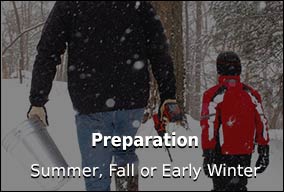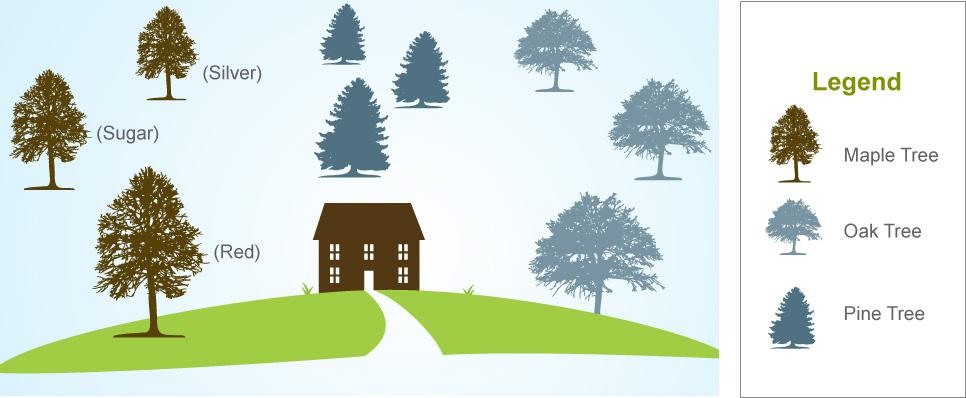 As with any endeavor, preparation is critical. It is important you are prepared with the knowledge of which trees in your yard are maples and that you have the necessary equipment. Do this before the sap starts to flow (sap flow typically begins in February or March).
As with any endeavor, preparation is critical. It is important you are prepared with the knowledge of which trees in your yard are maples and that you have the necessary equipment. Do this before the sap starts to flow (sap flow typically begins in February or March).
Identify Your Maple Trees – The Yard Map

The most effective way to identify maple trees is to create a map of your yard and record each type of tree (or at least the maples). If you try to tap an Oak tree, you will be greatly disappointed in the results. A great joke in Canada refers to tapping telephone poles, with the result being Pole Syrup (also known as imitation syrup such as Aunt Jemima® or Mrs. Butterworth’s®). The ideal time to prepare this map is in the Summer or Fall, when the leaves are still on the trees. If your trees have already lost their leaves, your maple trees can be identified based on other characteristics (see below links to commonly tapped maple trees). Identifying the type of maple tree is also important, as certain maples contain a higher sugar content, which will be described in later sections.
The most commonly tapped maple trees are Sugar, Black, Red, and Silver Maples. Click on the link of each tree for a detailed description of how to identify the tree.
While this site is focused on tapping your Maple trees, other types of trees can be tapped to collect sap, including Birch and Walnut trees.
Obtain Equipment Needed to Tap Trees
Obtain your equipment early, as supplies may become limited when the sap is flowing (that is the time of year everyone is purchasing equipment). The equipment needed to tap your trees can be grouped into two sections, equipment specific to tap the tree; and other general equipment (which you typically already own).
Equipment to Tap Trees
- Buckets: Used to collect the sap as it drips from the spile.
- Lids: Attached to the top of the bucket to prevent rain, snow, and foreign material from entering the bucket.
- Drill Bit: Depending upon the type of spile used, either a 5/16 or 7/16 drill bit is used to drill the tap hole into your maple tree.
- Spiles: The spile (or tap) is inserted into the drilled hole to transfer sap into the bucket.
- Hooks: Hooks are attached to the spile and used to hang the bucket.
- Cheesecloth: Used to filter any solids (such as pieces of bark) when transferring sap from the collection bucket to a storage container.
This equipment can be purchased on this site. Complete kits are offered in two varieties, with plastic buckets/lids or metal buckets/lids. The option to use plastic or metal is mainly a personal preference. The advantage of plastic buckets/lids is they will not dent or corrode. Metal buckets/lids create a more nostalgic image. We also offer a Spiles Kit with 4 spiles/hooks and step-by-step instructions.
Other General Equipment Needed
- Maple Trees: At a minimum, you need access to one mature (at least 12 inches in diameter), healthy maple tree. Many different types of maple trees can be tapped to collect sap, including Sugar Maple, Black Maple, Red Maple, and Silver Maple.
- Drill: A cordless drill is preferable, but a corded electric drill can be used with a properly insulated extension cord (long enough to reach the tree).
- Hammer: Used to gently tap the spile into the tap hole.
- Pliers: Used to remove the tap from the tree once the sap season is over.
- Storage Containers: Food grade storage containers are used to store your collected sap. Clean plastic milk jugs or juice containers may be used. You can also use food grade 5 gallon buckets. Your local deli or donut shop may provide these free of charge as they often receive their ingredients in such containers.
- Sap Processing Equipment: Depending upon how you decide to utilize your sap, additional equipment may be needed. For example, if you would like to make maple syrup, additional equipment is required. For small scale production, you can generally use items already available at home (refer to Collect Sap & Make Syrup section for details on making maple syrup).

